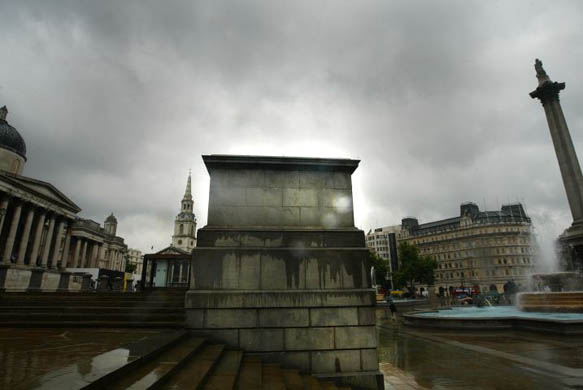 [Image: London’s Fourth Plinth, via Google Image search].
[Image: London’s Fourth Plinth, via Google Image search].
In an odd coincidence with the previous post, I actually saw a show at the American Museum of Natural History’s planetarium yesterday—an experience which reminded me not only how much I love planetaria, and that planetaria should be built all over the city, inside subway cars (and subway tunnels and subway stations), and inside children’s bedrooms, and in the back rooms of bookshops, in public buses, in bars, in department stores, in regular cinemas everywhere, in every city’s opera house, but I was reminded of the ongoing Fourth Plinth project in London.
The Fourth Plinth is the only plinth in Trafalgar Square without a statue; as such, it has been the site of (not always successful) public art installations for the past decade. But what if the Fourth Plinth, in tandem with London’s cloudy skies, could take on a more astronomical bent?
 [Image: Planetarium projection equipment].
[Image: Planetarium projection equipment].
A rain-proof planetarium machine could be installed in public, anchored to the plinth indefinitely. Lurking over the square with its strange insectile geometries, the high-tech projector would rotate, dip, light up, and turn its bowed head to shine the lights of stars onto overcast skies above. Tourists in Covent Garden see Orion’s Belt on the all-enveloping stratus clouds—even a family out in Surrey spies a veil of illuminated nebulae in the sky.
The Milky Way rolls over Downing Street. Videos explaining starbirth color the air above Pall Mall and St. Martin in the Fields goes quiet as ringed orbits of planets are diagrammed in space half a mile above its steeple.
 [Image: From a review of David Wright’s The Tenth Planet].
[Image: From a review of David Wright’s The Tenth Planet].
The sky becomes a writing board for astronomical imagery: planets rise and fall, constellations form, and the death of the universe is animated down to its slowest moment of heat-death. New shows are developed specifically for the London Planetarium, as Trafalgar Square is grudgingly called, and speakers installed in the nearby Pret A Manger allow customers to listen in while eating their evening sandwiches.
Eventually the idea is exported to other cloudy cities around the world. Astronomers in San Francisco’s Mission District project roiling animations of solar magnetism onto the fogbanks above Tank Hill.
As someone who used to work in a planetarium, I'm afraid I'm very skeptical about this marvelously mad idea. That's because clouds are nothing like ceilings, domed or otherwise, and trying to light up a small starlike spot on the bottom of a cloud seems difficult. You'd make a whole section of the cloud glow — maybe you could recreate van Gogh's "Starry Night" pretty accurately, though!
-Jim Moskowitz
This idea is much along the lines of one of my own, I'm so completely in agreement with you. Instead of clouds, why not use existing ceilings in public space?
The active use of audio visual technology in the public realm, I think, could spark a range of new interactions with the built environment and between people within it. I recently proposed such a design for the Grand Concourse area of the Bronx, NY, which you can see here:
AngusMcCullough.com
The connection of urban structures with the sky (and stellar structures) makes for a thrilling connection in my mind, and it's wonderful to know that there are other such dreamers out there. I truly do mean this to be a constructive comment, not a plug for my own idea, and I think your conception of such a system coming from the our mapping of the sky could bring newer, more international content to public spaces.
I think using existing ceilings in public space is a great idea. Altough you would probably have some pretty serious lighting issues. Next time youre in a planitarium try holding up your cell, you'll see what I mean.